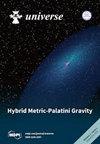Dissipative Kinematics in Binary Neutron Star Mergers
IF 2.5
4区 物理与天体物理
Q2 ASTRONOMY & ASTROPHYSICS
引用次数: 0
Abstract
We highlight the recent progress in the calculation of transport coefficients pertinent to binary neutron star mergers. Specifically, we analyze the bulk viscosity coefficient driven by both the DURCA and MURCA processes and electron transport coefficients in dense and hot plasma relevant to the merger scenario. The study considers high temperatures (T>6×1010 K) and dense environments (nB∼n0−3n0). Bulk viscosity exhibits resonant behavior, with peak values and Peak positions dependent on particle interaction rates and thermodynamic susceptibilities. Susceptibilities are calculated by modeling the nuclear matter in the density functional approach. The bulk viscosity coefficient peaks at T∼1011 K, with a compression–rarefaction oscillation dissipation time scale of 20–50 ms. Electrical transports incorporate frequency-dependent dynamical screening in quantized electron–ion scattering rates. Consequently, dynamical screening reduces the maxima of electrical and thermal conductivities, shortening corresponding dissipation time scales. These results highlight the crucial role of dissipation coefficients in understanding binary neutron star mergers.双中子星合并中的耗散运动学
我们重点介绍了在计算与双中子星合并相关的输运系数方面的最新进展。具体来说,我们分析了由DURCA和MURCA过程驱动的体积粘度系数,以及与合并情景相关的高密度和热等离子体中的电子传输系数。研究考虑了高温(T>6×1010 K)和高密度环境(nB∼n0-3n0)。体积粘度表现出共振行为,峰值和峰值位置取决于粒子相互作用率和热力学敏感性。敏感性是通过密度泛函方法中的核物质建模计算得出的。体积粘度系数在 T∼1011 K 时达到峰值,压缩-还原振荡耗散时间尺度为 20-50 ms。电子传输在量化的电子-离子散射率中加入了频率相关的动态屏蔽。因此,动态屏蔽降低了电导率和热导率的最大值,缩短了相应的耗散时间尺度。这些结果凸显了耗散系数在理解双中子星合并中的关键作用。
本文章由计算机程序翻译,如有差异,请以英文原文为准。
求助全文
约1分钟内获得全文
求助全文
来源期刊

Universe
Physics and Astronomy-General Physics and Astronomy
CiteScore
4.30
自引率
17.20%
发文量
562
审稿时长
24.38 days
期刊介绍:
Universe (ISSN 2218-1997) is an international peer-reviewed open access journal focused on fundamental principles in physics. It publishes reviews, research papers, communications, conference reports and short notes. Our aim is to encourage scientists to publish their research results in as much detail as possible. There is no restriction on the length of the papers.
 求助内容:
求助内容: 应助结果提醒方式:
应助结果提醒方式:


